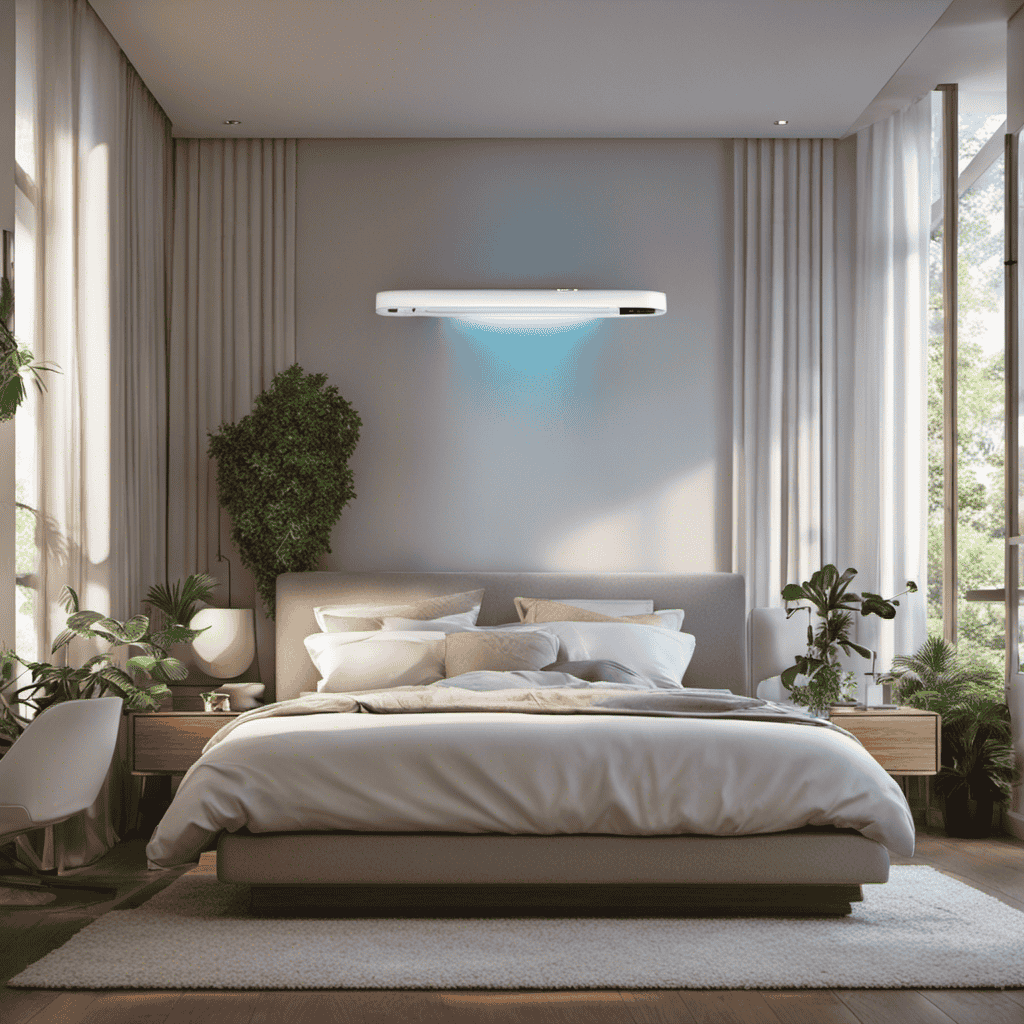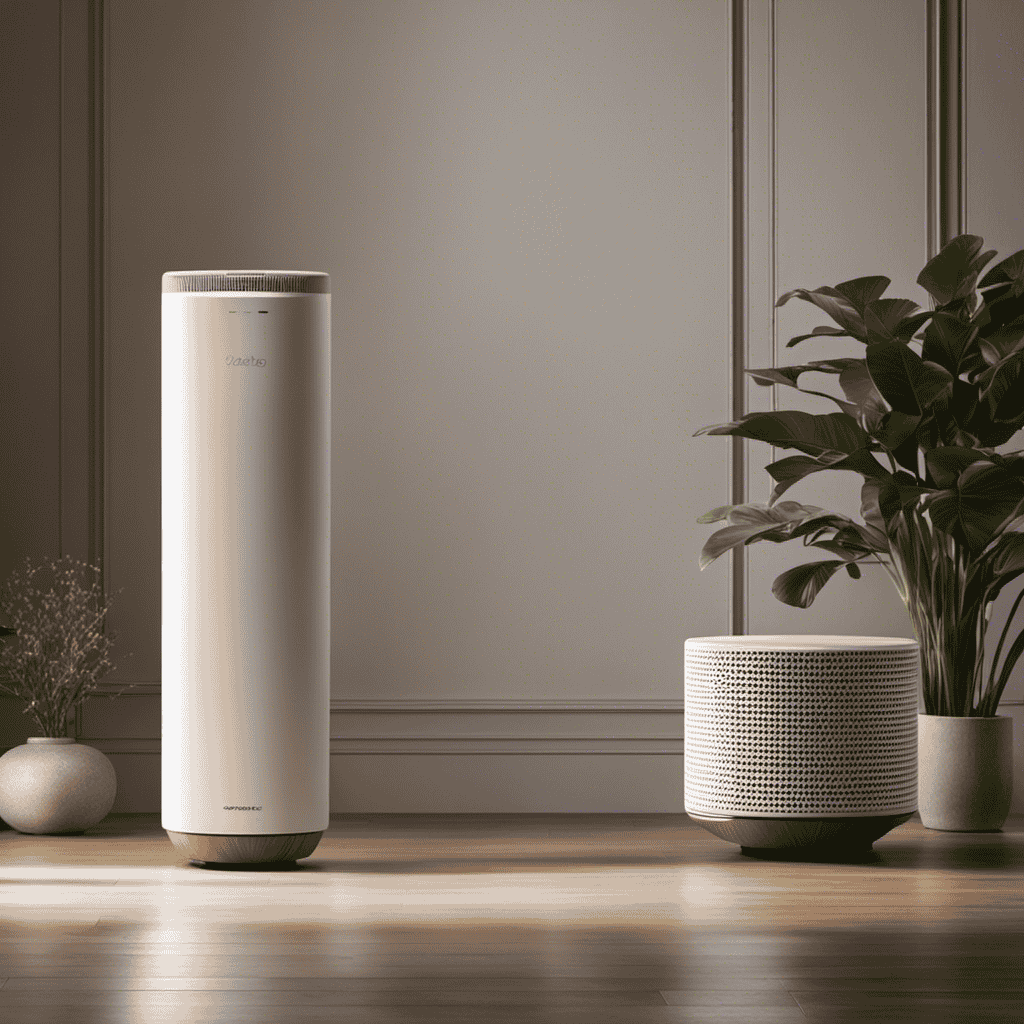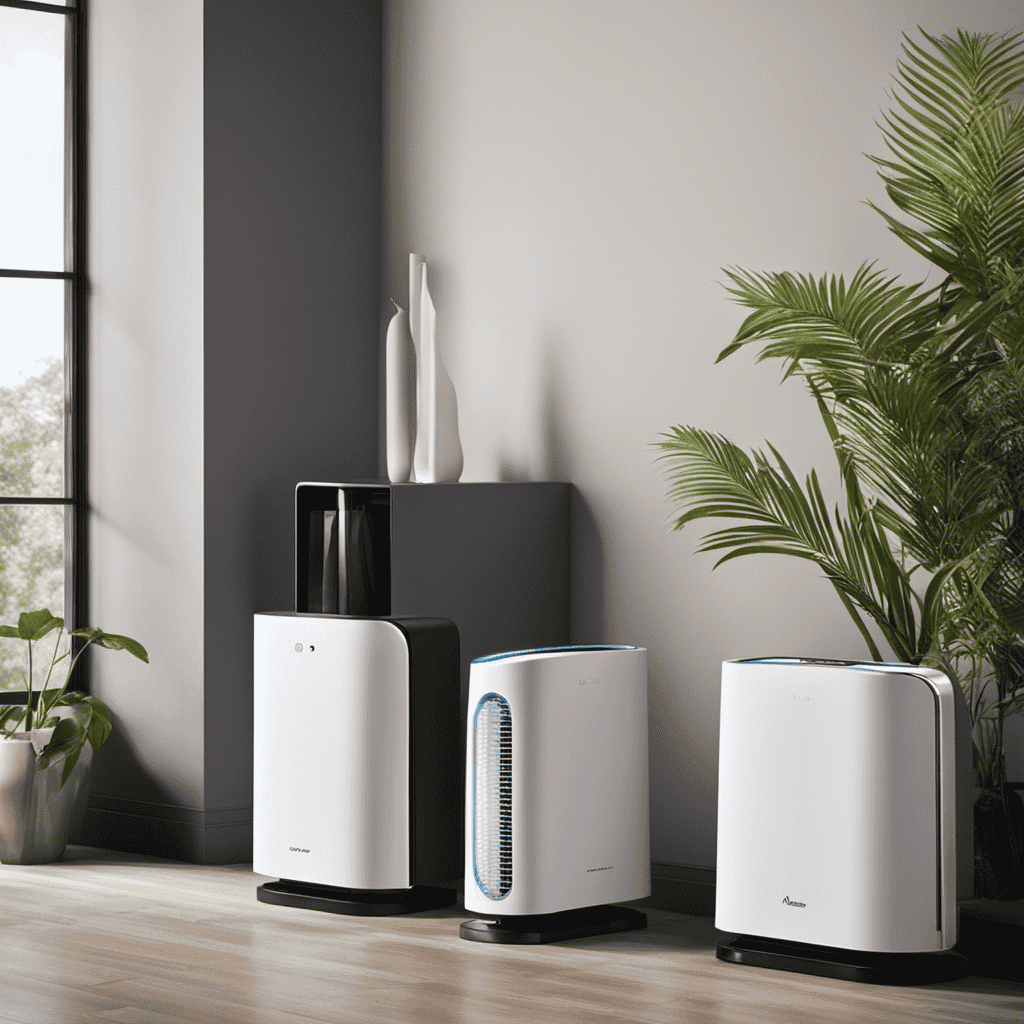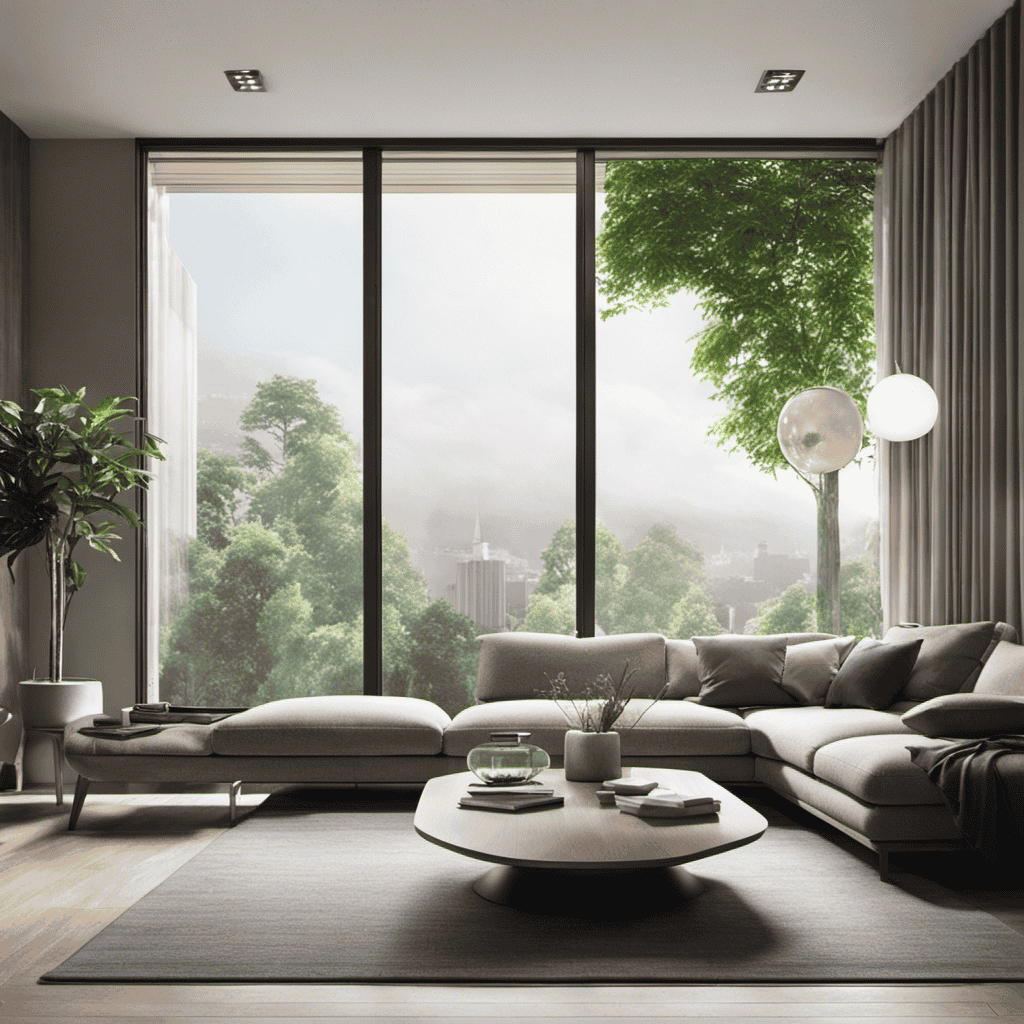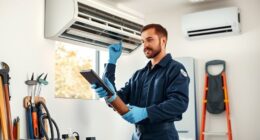As a person who has dealt with asthma, I have frequently questioned whether air purifiers can actually help alleviate my symptoms.
In this article, we’ll explore the effectiveness of air purifiers in alleviating asthma and improving indoor air quality. We’ll dive into the types of purifiers available, how they filter asthma triggers, and the role of HEPA filters in asthma management.
Additionally, we’ll address common concerns and misconceptions surrounding air purifiers and provide tips for choosing the right one for your specific needs.
Let’s breathe easier together.
Key Takeaways
- Air purifiers with HEPA filters are effective in capturing airborne particles and allergens, providing relief from asthma symptoms and improving respiratory health.
- Indoor air pollutants can trigger asthma attacks and worsen symptoms, but air purifiers can help reduce these triggers by filtering out pollutants and improving indoor air quality.
- Proper maintenance of air purifiers is crucial for their effectiveness in managing asthma, including regular cleaning and filter replacement.
- While air purifiers can be beneficial for asthma management, they should be used in combination with other strategies such as proper ventilation and medication adherence for optimal asthma control.
Types of Air Purifiers for Asthma Relief
If you have asthma, you’ll want to consider different types of air purifiers for relief. Comparing different air purifier brands is essential to find the most suitable one for your needs. When it comes to cost-effective air purifiers for asthma relief, there are a few options to consider.
One popular type of air purifier is the High-Efficiency Particulate Air (HEPA) filter. These filters are designed to capture tiny particles, including allergens and irritants that can trigger asthma symptoms. HEPA filters are highly effective in removing airborne pollutants and can significantly improve indoor air quality.
Another type of air purifier to consider is the activated carbon filter. These filters excel at removing odors, chemicals, and gases from the air. Although they may not directly target asthma triggers, they contribute to creating a healthier indoor environment by reducing the presence of various pollutants.
Ionic air purifiers are also worth exploring. These purifiers use charged ions to attract and remove contaminants from the air. They can effectively capture particles as small as 0.01 microns, making them suitable for asthma relief.
When comparing different air purifier brands, it’s essential to consider the Clean Air Delivery Rate (CADR), which indicates the purifier’s effectiveness in removing specific pollutants. Additionally, check if the purifier is certified by reputable organizations such as the Asthma and Allergy Foundation of America (AAFA).
Understanding the Impact of Indoor Air Quality on Asthma
Understanding the impact of indoor air quality on asthma can greatly improve management and reduce symptoms. Air pollution is a major trigger for asthma attacks and can worsen asthma control. Numerous studies have shown that exposure to indoor air pollutants, such as dust mites, pet dander, mold, and cigarette smoke, can lead to increased inflammation in the airways, leading to asthma symptoms. The presence of these pollutants can also make asthma medications less effective, making it harder to achieve optimal control.
Proper ventilation plays a crucial role in asthma management. Ventilation helps to remove indoor air pollutants and bring in fresh air. This can be achieved through the use of air purifiers, which filter out harmful particles from the air. Air purifiers with HEPA filters are particularly effective in removing allergens from the air, reducing asthma triggers. Additionally, opening windows and using exhaust fans can help improve indoor air quality by increasing air circulation.
How Air Purifiers Filter Asthma Triggers
Using HEPA filters, air purifiers effectively remove harmful particles from the air, reducing the presence of asthma triggers. Air purifier technology has come a long way in recent years, with advancements that specifically target the particles that can worsen asthma symptoms.
Here are some key features of modern air purifiers that help in reducing asthma triggers:
-
HEPA Filters: High-Efficiency Particulate Air (HEPA) filters are designed to capture particles as small as 0.3 microns. These filters are highly effective in removing common asthma triggers such as dust mites, pet dander, pollen, and mold spores.
-
Activated Carbon Filters: These filters are excellent at absorbing odors and volatile organic compounds (VOCs), which can also worsen asthma symptoms.
-
Ionizers: Some air purifiers use ionizers to charge particles in the air, causing them to stick to nearby surfaces or attach to an oppositely charged collector plate. This helps to reduce the overall particle count in the air.
-
UV-C Light: Ultraviolet (UV-C) light can be used in air purifiers to kill bacteria and viruses, which can be particularly beneficial for individuals with asthma who are prone to respiratory infections.
-
Smart Features: Many air purifiers now come with smart features such as air quality sensors and automatic modes, which allow the purifier to adjust its settings based on the detected air quality, providing optimal filtration for asthma triggers.
Investing in an air purifier with these features can greatly improve indoor air quality, reduce the presence of asthma triggers, and help manage asthma symptoms.
The Role of HEPA Filters in Asthma Management
Investing in an air purifier with HEPA filters can significantly improve indoor air quality, reducing the presence of asthma triggers and helping you manage your asthma symptoms. HEPA filters, or High Efficiency Particulate Air filters, are considered the gold standard in air purification technology. These filters are designed to capture 99.97% of airborne particles that are as small as 0.3 microns in size.
The importance of HEPA filters cannot be overstated when it comes to asthma management. Asthma triggers such as dust mites, pet dander, pollen, and mold spores are often present in our indoor environment. HEPA filters effectively trap these allergens, preventing them from circulating in the air and triggering asthma symptoms. By reducing the presence of these triggers, HEPA filters can help alleviate asthma symptoms and improve overall respiratory health.
Numerous studies have demonstrated the effectiveness of HEPA filters in improving indoor air quality and reducing asthma symptoms. One study published in the Journal of Allergy and Clinical Immunology found that using HEPA filters in the bedroom led to a significant reduction in asthma symptoms and improved lung function in asthmatic children. Another study published in the American Journal of Respiratory and Critical Care Medicine showed that using HEPA filters in homes resulted in a decrease in asthma exacerbations and improved quality of life for asthmatic adults.
Evaluating the Effectiveness of Air Purifiers for Asthma Symptoms
When it comes to evaluating the effectiveness of air purifiers, you’ll want to consider factors such as the type of filter used and the CADR rating. These two factors play a crucial role in determining how well an air purifier can improve air quality and alleviate asthma symptoms. However, it’s important to evaluate the long-term effectiveness of air purifiers and compare different brands to make an informed decision.
Here are some key points to consider when evaluating the long-term effectiveness of air purifiers for asthma symptoms:
-
Filter type: Look for air purifiers with HEPA filters, as they are highly effective at removing allergens and asthma triggers from the air.
-
CADR rating: Check the Clean Air Delivery Rate (CADR) rating of the air purifier to ensure it can effectively clean the air in your room size.
-
Noise level: Consider the noise level of the air purifier, especially if you plan to use it in your bedroom or living room.
-
Maintenance: Evaluate the ease of filter replacement and overall maintenance requirements of the air purifier.
-
Customer reviews: Read reviews from other asthma sufferers to get insights into the effectiveness and performance of different air purifier brands.
By carefully evaluating these factors, you can compare different brands and choose an air purifier that will effectively alleviate your asthma symptoms.
In the next section, we will discuss key features to look for in an air purifier specifically designed for asthma.
Key Features to Look for in an Air Purifier for Asthma
One important consideration is the noise level of the air purifier, especially if you plan to use it in your bedroom or living room. When looking for an air purifier for asthma management, there are several key features to keep in mind.
First, make sure the air purifier has a high-efficiency particulate air (HEPA) filter. These filters are designed to remove small particles, such as dust, pollen, pet dander, and mold spores, which can trigger asthma symptoms. Additionally, look for an air purifier with a pre-filter to capture larger particles and extend the life of the HEPA filter. Some air purifiers also have activated carbon filters, which can help remove odors and chemicals from the air.
Another important feature to consider is the size of the air purifier. It should be large enough to effectively clean the room where it will be used. Finally, look for an air purifier with adjustable fan speeds, so you can customize the airflow and noise level to your preference. These features can help improve indoor air quality and potentially reduce asthma symptoms.
Transition: Now that we’ve discussed the key features to look for in an air purifier for asthma, let’s explore the importance of proper maintenance for air purifiers and asthma control.
The Importance of Proper Maintenance for Air Purifiers and Asthma Control
When it comes to maintaining an air purifier for asthma control, there are three key points to consider.
First, regular filter replacement is crucial to ensure the device’s effectiveness.
Cleaning techniques, such as wiping down the exterior and using a vacuum attachment for the intake vents, can also enhance its performance.
Lastly, understanding the impact of proper maintenance on asthma symptoms is essential for individuals seeking relief from their condition.
Regular Filter Replacement
Regular filter replacement is essential for the effective functioning of air purifiers in helping with asthma symptoms. Here’s why regular maintenance is so important:
- Improved air quality: Filters trap allergens and pollutants, preventing them from circulating in the air and triggering asthma symptoms.
- Enhanced airflow: Clogged filters restrict airflow, reducing the purifier’s ability to clean the air effectively.
- Prolonged lifespan: Regularly replacing filters prevents damage to the purifier’s internal components, ensuring it lasts longer.
- Cost savings: While filter replacement may seem costly, it is more affordable than repairing or replacing a damaged purifier.
- Optimal performance: By ensuring clean filters, air purifiers can operate at their maximum efficiency, providing the best asthma relief.
Now that we understand the effectiveness of regular maintenance and the cost considerations for filter replacement, let’s explore some cleaning techniques to maximize the purifier’s effectiveness.
Cleaning Techniques for Effectiveness
Now that we have discussed the importance of regular filter replacement, let’s move on to cleaning techniques for maintaining the effectiveness of air purifiers. Proper cleaning not only ensures that the device continues to function optimally but also helps to remove allergens and pollutants from the air. Here are some maintenance tips to keep in mind:
-
Dust and wipe down regularly: Use a soft, damp cloth to wipe the exterior of the air purifier. This will help remove dust and debris that can accumulate over time.
-
Clean the filters: Follow the manufacturer’s instructions for cleaning and replacing the filters. This is crucial for maintaining the purifier’s efficiency in capturing particles.
-
Vacuum the vents: Use a vacuum cleaner with a brush attachment to gently clean the vents and grilles of the air purifier. This will prevent dust and dirt from obstructing the airflow.
-
Check for mold: Inspect the unit regularly for any signs of mold growth. If you notice mold, clean it immediately using a mild detergent and water solution.
Impact on Asthma Symptoms
To alleviate symptoms of asthma, it’s important to keep in mind the impact that clean air can have on your respiratory health. Clean air can help reduce the irritation and inflammation of the airways, making it easier to breathe.
Here are some ways in which clean air can positively affect asthma symptoms:
- Reduces exposure to air pollutants and allergens
- Decreases the need for medication
- Supports lung function and improves overall respiratory health
- Provides a safer and healthier living environment
- Offers an alternative treatment option for asthma management
By improving air quality, individuals with asthma may experience fewer symptoms and may even require less medication to control their condition. This can be especially beneficial for those who may be sensitive to certain medications or are seeking alternative treatments.
Now, let’s explore expert recommendations on using air purifiers for asthma relief.
Expert Recommendations on Using Air Purifiers for Asthma Relief
When it comes to finding relief from asthma symptoms, many people turn to air purifiers. But how effective are these devices really?
In this discussion, we will explore the effectiveness of air purifiers in providing long-term relief for asthma sufferers and identify the best air purifier options available on the market.
Air Purifier Effectiveness
Air purifiers can significantly reduce asthma symptoms. As someone who suffers from asthma, I can attest to the effectiveness of air purifiers in improving indoor air quality and reducing triggers that can worsen asthma symptoms. But it’s important to note that regular maintenance is crucial for optimal performance.
Here are some key points to consider:
- Change filters regularly to ensure they are clean and functioning properly.
- Clean the exterior of the purifier to remove dust and allergens that may accumulate.
- Monitor the air quality indicators on the purifier to ensure it is working efficiently.
- Place the purifier strategically in the room to maximize its effectiveness.
- Consider the size of the purifier in relation to the room size for optimal coverage.
Best Air Purifier
The best air purifier for alleviating asthma symptoms is one that effectively reduces triggers and improves indoor air quality. When looking for the best air purifier, it is important to consider its effectiveness in removing allergens such as dust mites, pollen, pet dander, and mold spores from the air.
HEPA (High-Efficiency Particulate Air) filters are highly recommended for asthma sufferers as they can capture particles as small as 0.3 microns with an efficiency of 99.97%. Additionally, look for air purifiers with activated carbon filters, which can effectively remove odors and volatile organic compounds (VOCs) from the air.
It is also important to choose an air purifier with a sufficient coverage area for your room size. Remember to regularly change the filters to maintain the purifier’s effectiveness.
Long-Term Asthma Relief?
To achieve long-term relief from asthma, it’s crucial to consider the effectiveness of air purifiers in reducing triggers and improving indoor air quality. Air purifiers can be a valuable addition to your long-term management plan for asthma. Here are some key points to consider:
- Air purifiers can remove allergens such as dust mites, pet dander, and pollen from the air, reducing the potential for asthma attacks.
- They can also filter out harmful pollutants like smoke, mold spores, and volatile organic compounds (VOCs), which can aggravate asthma symptoms.
- Air purifiers with HEPA filters are highly effective in capturing even tiny particles, providing cleaner air for asthma sufferers.
- Some air purifiers also come with additional features like ionizers or UV-C lights, which can further enhance air purification.
- Incorporating air purifiers into your asthma management plan can provide an alternative solution to medication or reduce reliance on it.
Considering these benefits, it’s important to address common concerns and misconceptions about air purifiers and asthma.
Addressing Common Concerns and Misconceptions About Air Purifiers and Asthma
If you’re worried that air purifiers won’t effectively alleviate your asthma symptoms, rest assured that they have been shown to reduce airborne triggers and improve air quality in your home. Let’s address some common concerns and misconceptions about air purifiers and asthma.
One common myth is that air purifiers only provide temporary relief. However, studies have found that air purifiers can provide long-term benefits for asthma sufferers. By filtering out allergens and irritants from the air, they help create a cleaner and healthier indoor environment, which can lead to a reduction in asthma symptoms over time.
Another misconception is that air purifiers are only effective for outdoor pollutants. While it’s true that air purifiers can help remove outdoor pollutants that have made their way inside, they are also effective at capturing indoor pollutants such as dust mites, pet dander, and mold spores. These indoor triggers can worsen asthma symptoms, so having an air purifier can be beneficial.
Furthermore, some people worry that air purifiers are noisy or expensive to run. However, many modern air purifiers are designed to operate quietly, making them suitable for use in bedrooms or living areas. Additionally, energy-efficient models are available, which can help keep running costs down.
Additional Strategies to Complement Air Purifiers in Managing Asthma
When managing your asthma, consider incorporating other strategies alongside air purifiers, such as maintaining a clean and dust-free living environment. While air purifiers can help remove airborne irritants and allergens, there are complementary therapies and lifestyle changes that can further enhance your asthma management.
Here are five additional strategies to consider:
-
Regular exercise: Engaging in physical activity can improve lung function and overall respiratory health, reducing the frequency and severity of asthma symptoms.
-
Breathing exercises: Techniques like deep breathing and diaphragmatic breathing can help strengthen your respiratory muscles and improve lung capacity.
-
Allergen control: Identify and eliminate common allergens in your living space, such as dust mites, pet dander, and mold. Regularly clean and vacuum your home, wash bedding in hot water, and use hypoallergenic covers on pillows and mattresses.
-
Stress management: Stress can trigger asthma symptoms, so finding effective stress management techniques like mindfulness, meditation, or yoga can help reduce the impact on your respiratory system.
-
Healthy diet: A balanced diet rich in fruits, vegetables, whole grains, and lean proteins can provide essential nutrients and antioxidants that support lung health.
By incorporating these complementary therapies and making lifestyle changes, you can optimize your asthma management and improve your overall quality of life.
Remember to consult with your healthcare provider for personalized recommendations and guidance.
Research and Studies on the Benefits of Air Purifiers for Asthma
Research and studies have shown the potential benefits of using air purifiers to manage asthma symptoms. Air purifiers are devices that help improve indoor air quality by removing allergens and irritants such as dust, pet dander, mold spores, and pollen from the air. This can be particularly beneficial for individuals with asthma, as these triggers can exacerbate their symptoms and lead to asthma attacks.
Several studies have examined the effectiveness of air purifiers in providing long-term relief for asthma. One study published in the Journal of Allergy and Clinical Immunology found that using a high-efficiency particulate air (HEPA) filter reduced asthma symptoms and the need for medication in children with asthma. Another study published in the Journal of Asthma showed that air purifiers with activated carbon filters significantly reduced asthma symptoms and improved lung function in adults with moderate to severe asthma.
To further illustrate the effectiveness of air purifiers, consider the following table:
| Study | Participants | Results |
|---|---|---|
| Study 1 | Children with asthma | Reduced symptoms and medication usage |
| Study 2 | Adults with asthma | Improved lung function and reduced symptoms |
| Study 3 | Asthma patients | Decreased asthma exacerbations and improved quality of life |
These findings demonstrate the potential benefits of using air purifiers in managing asthma symptoms. However, it is important to note that air purifiers should be used in conjunction with other asthma management strategies, such as proper medication adherence, regular exercise, and maintaining a clean and dust-free environment. Consulting with a healthcare professional is recommended to determine the most suitable course of action for individual asthma management.
Tips for Choosing the Right Air Purifier for Your Asthma Needs
To select the most suitable air purifier for managing your asthma symptoms, consider factors such as the size of the room, the type of filter, and the noise level of the device. These criteria will help you make an informed decision and find the best air purifier for your needs.
Here are some tips to guide you in choosing the right air purifier:
-
Room size: Determine the square footage of the room you want to purify. Different air purifiers are designed to cover different room sizes, so it’s important to choose one that can effectively clean the air in your space.
-
Filter type: Look for air purifiers with HEPA filters, as they are highly effective in removing airborne allergens and pollutants. HEPA filters can trap particles as small as 0.3 microns, including dust, pollen, pet dander, and mold spores.
-
Noise level: Consider the noise level of the air purifier, especially if you plan to use it in your bedroom or living room. Look for models with a quiet operation, so it doesn’t disturb your sleep or daily activities.
-
Brand comparison: Research different brands and compare their features, customer reviews, and ratings. Look for reputable brands that have a proven track record in producing high-quality air purifiers.
-
Additional features: Some air purifiers come with additional features like air quality sensors, auto mode, and programmable timers. These features can enhance the performance and convenience of the device.
Frequently Asked Questions
Are There Any Side Effects of Using Air Purifiers for Asthma Relief?
When it comes to air purifiers for asthma relief, it’s important to consider any potential side effects.
While air purifiers are generally safe and effective, some individuals may experience minor side effects such as dryness or irritation of the nose and throat.
However, these effects are usually temporary and can be minimized by using a high-quality air purifier with a HEPA filter.
It’s always best to consult with a healthcare professional for personalized advice and guidance.
Can Air Purifiers Completely Eliminate Asthma Triggers From Indoor Air?
Air purifiers can make a noticeable difference in reducing asthma triggers in indoor air. They act like superheroes, swooping in to capture and eliminate harmful particles like dust, pollen, and pet dander.
However, it’s important to note that while air purifiers are effective, they may not completely eliminate all triggers.
It’s also worth considering the cost of air purifiers and weighing it against the potential benefits they provide for asthma relief.
How Long Does It Take for an Air Purifier to Show Noticeable Improvements in Asthma Symptoms?
When considering the duration of air purifier effectiveness and the factors affecting its impact on asthma symptoms, it’s important to understand that air purifiers can offer relief by removing airborne allergens and irritants.
However, the speed at which noticeable improvements occur may vary depending on factors such as the severity of asthma, the size of the room, and the quality of the air purifier.
It’s recommended to use air purifiers consistently and in conjunction with other asthma management strategies for the best results.
Are There Any Specific Air Purifier Brands or Models Recommended for Asthma Management?
There are definitely affordable air purifier options for managing asthma. When choosing the right size air purifier for asthma relief, it’s important to consider the square footage of the room where it will be used.
Look for air purifiers with HEPA filters, as they are highly effective in removing allergens and asthma triggers from the air.
Some recommended brands for asthma management include Honeywell, Blueair, and Coway.
Can Air Purifiers Replace Other Asthma Management Strategies, Such as Medication or Avoiding Triggers?
Air purifiers offer an additional layer of protection against asthma triggers, but they cannot replace other management strategies like medication or trigger avoidance. While they can help reduce airborne allergens and improve indoor air quality, their effectiveness may vary.
It’s important to consult with a healthcare professional to determine the best course of action for managing asthma. Air purifiers should be viewed as a complementary tool rather than a replacement for existing treatments, such as allergy shots.
Conclusion
In conclusion, after delving into various types of air purifiers and their effectiveness in managing asthma symptoms, it is evident that these devices can be a valuable addition to an asthma management plan.
Research and studies have shown that air purifiers with HEPA filters can effectively filter out asthma triggers, improving indoor air quality.
While they may not completely eliminate all triggers, they can significantly reduce exposure and alleviate symptoms.
So, don’t hesitate to invest in an air purifier and breathe easier with asthma!
